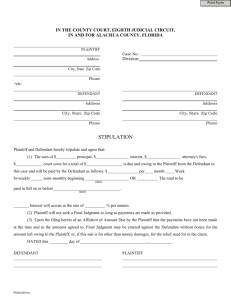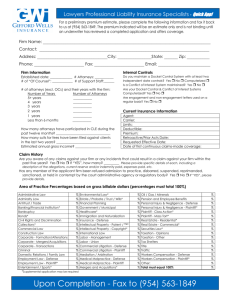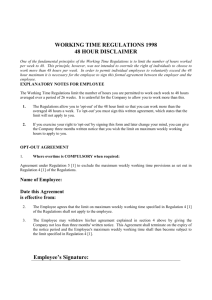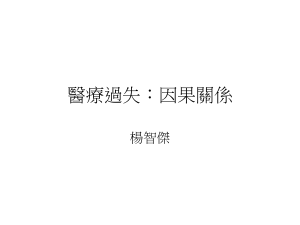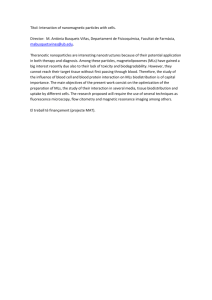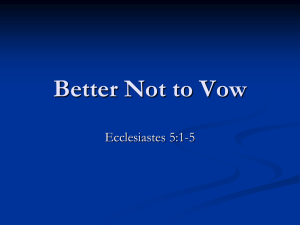Motion to Dismiss Memorandum
advertisement
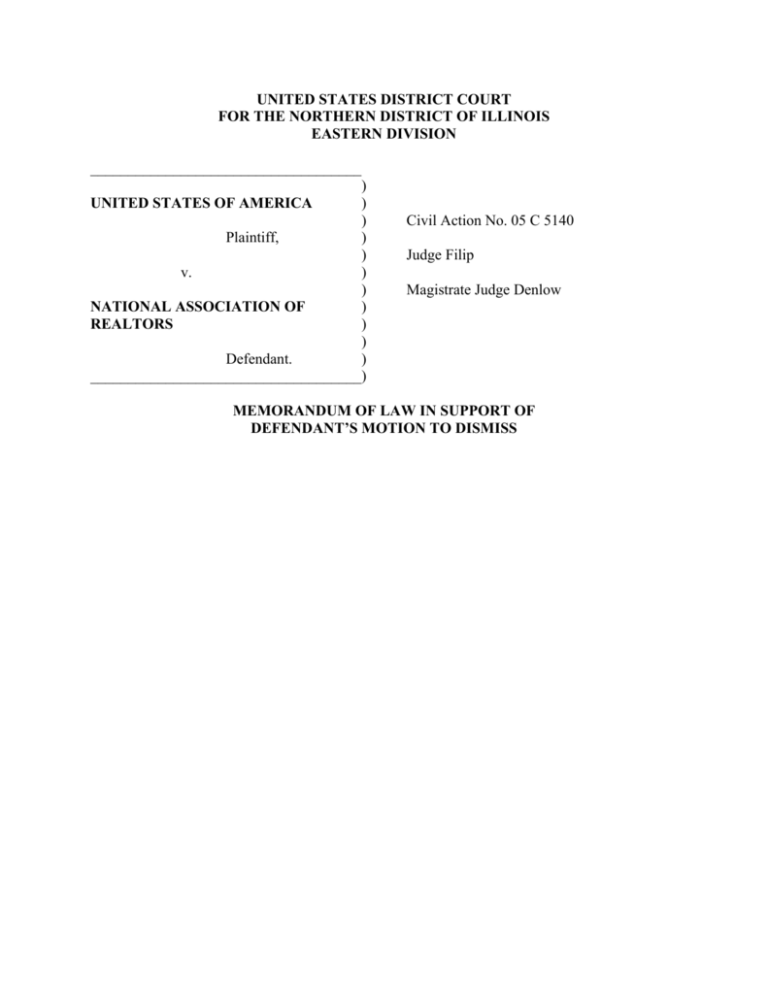
UNITED STATES DISTRICT COURT FOR THE NORTHERN DISTRICT OF ILLINOIS EASTERN DIVISION ____________________________________ ) ) ) Plaintiff, ) ) v. ) ) NATIONAL ASSOCIATION OF ) REALTORS ) ) Defendant. ) ____________________________________) UNITED STATES OF AMERICA Civil Action No. 05 C 5140 Judge Filip Magistrate Judge Denlow MEMORANDUM OF LAW IN SUPPORT OF DEFENDANT’S MOTION TO DISMISS TABLE OF CONTENTS TABLE OF AUTHORITIES .......................................................................................................... ii INTRODUCTION ...........................................................................................................................1 FACTUAL ALLEGATIONS ..........................................................................................................3 A. The 2003 VOW Policy.................................................................................4 B. The 2005 ILD Policy. ..................................................................................6 C. Allegations Of Anticompetitive Effect. .......................................................7 ARGUMENT...................................................................................................................................8 I. THIS COURT LACKS JURISDICTION TO ADJUDICATE THE 2003 VOW POLICY.........................................................................................................8 II. THE AMENDED COMPLAINT FAILS TO STATE A CLAIM WITH RESPECT TO THE OPT-OUT PROVISIONS OF EITHER POLICY................12 III. THE AMENDED COMPLAINT FAILS ADEQUATELY TO ALLEGE ANY ANTICOMPETITIVE EFFECTS FROM THE BLANKET, RECIPROCAL OPT-OUT PROVISION OF THE 2005 ILD POLICY. ..............19 CONCLUSION..............................................................................................................................22 TABLE OF AUTHORITIES CASES Associated Gen. Contractors v. Cal. State Council of Carpenters, 459 U.S. 519 (1983)...........................................................................................................20 Associated Press v. United States, 326 U.S. 1 (1945)...............................................................................................................18 Austin Board of Realtors v. E-Realty, Inc., 2000 WL. 34239114 (W.D. Tex. Mar. 30, 2000) ..............................................................16 Austin Board of Realtors v. E-Realty, Inc., No. 00-CA-154, Sept. 13, 2000 Order ...............................................................................16 BCB Anesthesia Care v. Passavant Mem. Area Hosp. Ass’n, 36 F.3d 664 (7th Cir. 1994) ...............................................................................................20 Berry v. Farmland Ind., Inc., 114 F. Supp. 1150 (D. Kan. 2000).....................................................................................10 Bi-Rite Oil Co. v. Indiana Farm Bureau Coop. Assoc., Inc., 908 F.2d 200 (7th Cir. 1990) .............................................................................................19 California Dental Ass’n v. FTC, 526 U.S. 756 (1999)...........................................................................................................13 City of Los Angeles v. Lyons, 461 U.S. 95 (1983)...............................................................................................................9 Consolidated Metal Products v. American Petroleum Institute, 846 F.2d 284 (5th Cir. 1988) .............................................................................................15 DM Research, Inc. v. College of American Pathologists, 170 F.3d 53 (1st Cir. 1999)................................................................................................20 FTC v. Indiana Federation of Dentists, 476 U.S. 447 (1986)...........................................................................................................14 FTC v. Superior Court Trial Lawyers Ass’n, 493 U.S. 411 (1990)...........................................................................................................14 Friends of the Earth, Inc. v. Laidlaw Environmental Services (TOC), Inc., 528 U.S. 167 (2000).......................................................................................................9, 10 ii Jackson v. E.J. Brach Corp., 176 F.3d 971 (7th Cir. 1999) ...............................................................................................3 Lerma v. Univision Communications, 52 F. Supp. 1011 (E.D. Wis. 1999)....................................................................................20 Menominee Indian Tribe of Wisconsin v. Thompson, 161 F.3d 449 (7th Cir. 1998) ...............................................................................................1 NCAA v. Board of Regents, 468 U.S. 85 (1984).............................................................................................................13 National Society of Professional Engineers v. United States, 435 U.S. 679 (1978)...........................................................................................................14 O’Shea v. Littleton, 414 U.S. 488 (1974).......................................................................................................9, 11 Palda v. General Dynamics Corp., 47 F.3d 872 (7th Cir. 1995) ...............................................................................................20 San Francisco Baykeeper, Inc. v. Moore, 180 F. Supp. 2d 1116 (E.D. Cal. 2001)..............................................................................10 Santana Products Inc. v. Bobrick Washroom Equipment, Inc., 401 F.3d 123 (3d Cir. 2005)...............................................................................................13 Schachar v. American Academy of Ophthalmology, 870 F.2d 397 (7th Cir. 1989) ..................................................................................... passim Sierakowski v. Ryan, 223 F.3d 440 (7th Cir. 2000) ...............................................................................................9 Silver v. New York Stock Exchange, 373 U.S. 341 (1963)...........................................................................................................14 Spanish Broadcasting Sys. of Florida, Inc. v. Clear Channel Communications, Inc., 376 F.3d 1065 (11th Cir. 2004) .........................................................................................20 Steel Co. v. Citizens for a Better Environment, 523 U.S. 83 (1998)...................................................................................................9, 10, 11 Stevens v. Northwest Indiana Dist. Council, United Brotherhood of Carpenters, 20 F.3d 720 (7th Cir. 1994) ...............................................................................................10 iii United States v. Concentrated Phosphate Export Ass’n, 393 U.S. 199 (1968)...........................................................................................................10 United States v. Realty Multi-List, Inc., 629 F.2d 1351 (5th Cir. 1982) .............................................................................................1 Vogel v. American Society of Appraisers, 744 F.2d 598 (7th Cir. 1984) .............................................................................................14 Wernsing v. Thompson, 423 F.3d 732 (7th Cir. 2005) ...............................................................................................9 Wilk v. American Medical Association, 895 F.2d 352 (7th Cir. 1990) .......................................................................................15, 16 Wooden v. Board of Regents, 247 F.3d 1262 (11th Cir. 2001) ...........................................................................................9 STATUTES 15 U.S.C. § 1.......................................................................................................................... passim 15 U.S.C. § 4....................................................................................................................................9 iv INTRODUCTION In this case, plaintiff United States challenges two policies of the National Association of Realtors® (“NAR”) addressing the display of a real estate broker’s listings on the websites of other brokers. The first policy, adopted in May of 2003, governed the display of listings on password protected websites – known as Virtual Office Websites (“VOWs”) – on which a consumer must register and enter into a broker-client relationship before receiving access to the listings on the site. The basic presumption of this 2003 VOW Policy was that the listings of any participant in a multiple listing service (“MLS”)1 could be displayed on the VOW of any other MLS participant. (See Ex. 1 at I.3).2 However, each listing broker remained free to make a unilateral decision that it would not authorize the display of its listings on VOWs operated by particular MLS participants on which it did not want those listings to appear (“selective opt-out”) – or on any VOWs of other MLS participants (“blanket opt-out”). Shortly after the 2003 VOW Policy was adopted, plaintiff launched an investigation of the Policy – with particular focus on the competitive significance of the selective opt-out provision. The uncertainties created by the investigation caused NAR to advise MLSs operated by associations of Realtors® that they need not implement the Policy.3 Consequently, 1 An MLS is a joint venture among real estate brokers through which participants share information on properties that are for sale in order to find buyers for the properties in an efficient manner. See United States v. Realty Multi-List, Inc., 629 F.2d 1351, 1355-56 (5th Cir. 1982). 2 A true and correct copy of the 2003 VOW Policy is attached as Exhibit 1 to the Affidavit of Laurene K. Janik (“Janik Affidavit”), filed herewith. On this motion to dismiss, the Court may take judicial notice of documents which are referred to in the Complaint and are central to plaintiff’s claim. Menominee Indian Tribe of Wisconsin v. Thompson, 161 F.3d 449, 456 (7th Cir. 1998). 3 The term “Realtor®” is a collective membership mark indicating that a real estate broker or agent so designated is a member of NAR. according to the Amended Complaint, the 2003 VOW Policy was implemented by only approximately 200 of 1,600 such MLSs. (Am. Compl. ¶ 31). Toward the end of the investigation, plaintiff and NAR held an extensive series of discussions about the 2003 VOW Policy. (Janik Aff. ¶ 5). Based in part on a desire to address the concerns expressed by plaintiff and in part on a desire to have a single policy governing all displays of MLS listing information on all websites operated by MLS participants,4 NAR on August 31, 2005 rescinded the 2003 VOW Policy. (Id.). On the same date, NAR adopted in its place a new policy entitled the “Internet Listing Display Policy” (the “2005 ILD Policy”). (Id. at ¶ 6).5 Besides applying to all websites operated by MLS participants, the 2005 ILD Policy abandoned many of the features to which plaintiff had objected. Perhaps most significantly, the 2005 ILD Policy does not contain a selective opt-out provision. Instead, an MLS participant may prevent its listings from being displayed on the websites of other MLS participants only by (a) preventing its listings from being displayed on the websites of all other MLS participants, and (b) not displaying on its own website the listings of any other MLS participants. (See 2005 ILD Policy at § I.3). Thus, the selective opt-out has been replaced with an opt-out that is blanket and reciprocal. Significantly, the 2005 ILD Policy retains the basic presumption that all MLS listings may be displayed on the websites of all MLS participants. Like the 2003 VOW Policy, a listing broker need take no action to permit its listings to be displayed on the websites of other 4 The 2003 VOW Policy applied only to password protected sites accessible only to consumers who entered into a broker-client relationship with the operator of the site. The 2005 ILD Policy applies both to these sites and to generally accessible sites on which listings are advertised. 5 A true and correct copy of the 2005 ILD Policy is attached as Exhibit 2 to the Janik Affidavit, filed herewith. 2 brokers. Thus, the 2003 VOW Policy did not, and the 2005 ILD Policy does not, prevent the display of any listings on any broker’s websites. Rather, listing brokers are free to make their own independent decisions regarding display of their listings on the websites of others. Despite the rescission of the 2003 VOW Policy on August 31, 2005, plaintiff sued NAR on September 8. It filed an Amended Complaint on October 4, 2005. The Amended Complaint challenges both the rescinded 2003 VOW Policy and the 2005 ILD Policy. NAR brings this motion to dismiss on three grounds: 1. This Court lacks jurisdiction to adjudicate the lawfulness of the 2003 VOW Policy because that Policy was rescinded prior to the initiation of this lawsuit. 2. The selective and general opt-out provision of the 2003 VOW Policy did not, and the blanket and reciprocal opt-out provision of the 2005 ILD Policy does not, involve any collectively-imposed restraint of trade. Thus, neither opt-out provision can violate Section 1 of the Sherman Act, 15 U.S.C. § 1. 3. The allegations of the Amended Complaint regarding anticompetitive effects of the 2005 ILD Policy are insufficient to state a cause of action against that Policy under Section 1 of the Sherman Act. FACTUAL ALLEGATIONS6 A multiple listing service is a joint venture among real estate brokers to share their clients’ listings and to cooperate in other ways. (Am. Compl. ¶¶ 21-22). Defendant NAR is a national trade association of real estate professionals. (Id. ¶ 11). From time to time, NAR 6 For the purposes of this motion to dismiss, NAR assumes that the factual allegations are true. See Jackson v. E.J. Brach Corp., 176 F.3d 971, 977 (7th Cir. 1999). 3 promulgates rules governing the conduct of the MLSs operated by its member local associations of Realtors®. (Id. ¶ 22). In the late 1990s, some brokers “began creating password-protected websites that enabled potential home buyers, once they had registered as customers of the broker and agreed to certain restrictions on their use of the data, to search the MLS database themselves and to obtain responsive MLS listings over the Internet. These websites came to be known as virtual office websites or VOWs.” (Am. Compl. ¶ 26). Until 2003, NAR had not adopted a policy concerning the display of MLS listings on VOWs. (Janik Aff. at ¶ 3). A. The 2003 VOW Policy. On May 17, 2003, NAR adopted the 2003 VOW Policy. (Am. Compl. ¶ 31). While plaintiff challenges various features of the 2003 VOW Policy, the Amended Complaint focuses on one aspect of the Policy, the opt-out provision.7 That provision reads as follows: Use of MLS active listing data on a VOW is subject to the permission of the listing brokers whose listings may be available to consumers via a VOW. Unless otherwise prohibited by state law or regulation, such permission is presumed unless a listing broker “opts out” by directing that his or her listings not be available for search or display on the VOWs of other participants. A listing broker may independently elect to opt out of (i) the VOWs of all other participants in the MLS (“Blanket opt out”), or (ii) the VOWs of selected other participants determined independently by the listing broker (“Selective opt out.”) (Ex. 1 at § I.3). As the Policy explicitly stated, a listing broker was presumed to permit display of its listings on the VOWs of all other participants. If a listing broker took no action, its listings could appear on the VOWs of other MLS participants. However, a listing broker could make a unilateral decision to withhold its listings from display on the VOWs of other MLS participants. 7 Plaintiff also challenges the 2003 VOW Policy provisions governing referrals and advertising. (Am. Compl. ¶¶ 35-36). 4 The 2003 VOW Policy allowed listing brokers to opt-out either in blanket fashion (so that no other MLS participants could display that broker’s listings on their VOWs) or selectively (so that only certain specified MLS participants would not be permitted to display the listings on their VOWs). In addition, as plaintiff recognizes, the 2003 VOW Policy applied only to the display of listings on certain websites, i.e., password protected sites known as VOWs, to which a consumer could gain access only after forming a broker-client relationship with the VOW operator. (Am. Compl. ¶ 26). Plaintiff does not challenge any pre-existing NAR policy concerning the display of listings on the generally and publicly accessible websites of brokers. Nor does it suggest that it was inappropriate for NAR policies to permit listing brokers to prevent their listings from being displayed on the generally and publicly accessible websites of other brokers. Initially, the 2003 VOW Policy set a deadline of January 1, 2004 for local MLSs to implement it. (Ex. 1 at p. 6). In light of the Justice Department’s investigation, NAR pushed the deadline for implementation back to January 1, 2006. (Am. Compl. ¶ 31). Although approximately 200 MLSs (out of a total of 1,600) voluntarily adopted the 2003 VOW Policy earlier than required (id. ¶ 31), the Policy was rescinded prior to the implementation deadline. According to the Complaint, in September 2005, NAR “advised its member boards to suspend application and enforcement of the” 2003 VOW Policy, and announced that it was adopting a new policy regarding the display of listings on the internet. (Am. Compl. ¶ 38). In fact, NAR rescinded the 2003 VOW Policy on August 31, 2005. (See Janik Aff. at ¶ 5). 5 B. The 2005 ILD Policy. The new 2005 ILD Policy was adopted on August 31, 2005. (Ex. 2 at p. 4 (“policy shall become effective on August 31, 2005”)). On the opt-out issue,8 the 2005 ILD Policy provides: 3. Unless state law requires prior written consent, each Participant’s consent for display of that Participant’s listings on the ILD site of other MLS Participants is presumed unless a Participant affirmatively notifies that MLS in writing that it has withdrawn consent to such display (“opt out”). (a) A Participant that opts out may not display on its ILD site(s) (including by framing another website), if any, the listings of any other MLS Participant provided by the MLS. (b) A Participant that opts out may not display its listings on any ILD site of any other Participant. It may, however, display its listings on public websites of third parties, including but not limited to Realtor.com. (c) A decision to opt out may not be revoked for a period of ninety (90) days from the date the decision becomes effective. (Ex. 2 at § I.3). Like the 2003 VOW Policy, the 2005 ILD Policy presumes that a listing broker consents to other MLS participants displaying the listing on their websites. Unless a listing broker affirmatively takes action, its listings are available for display on other broker’s websites. But the opt-out feature of the 2005 ILD Policy is significantly different from that of the 2003 VOW Policy in two respects. 8 Beyond the opt-out feature of the 2005 ILD Policy, plaintiff challenges that Policy’s provisions regarding membership, data feed quality, and “cobranding” relationships. (Id. ¶¶ 40-41). These features of the 2005 ILD Policy are not the subject of this motion. 6 First, the 2005 ILD Policy removes the selective opt-out option. If a listing broker opts out, then its listings will not appear on the websites of any other MLS participant. (Ex. 2. at § I.3(b)). In addition, if a listing broker opts out, it may not display the listings of any other broker on its website. (Id. at § I.3(a)). Under the 2005 ILD Policy, no broker may “target” the website of any other broker, and a broker that opts out is deprived of the opportunity to display the listings of other brokers on any website that it operates. Second, the 2003 ILD Policy applies to the display of listings anywhere on the websites of other brokers – whether on password protected sites to which a user has access only after forming a broker-client relationship, or on generally accessible sites. Significantly, although plaintiff seeks to enjoin the opt-out provision of the 2005 ILD Policy in its entirety (Am. Compl. at p. 14), nowhere does it discuss the fact that the 2005 ILD Policy applies not only to VOWs (as did the 2003 VOW Policy), but also generally to the display of listings by a broker on any of its websites. In short, plaintiff claims not only that it is unlawful for NAR to permit listing brokers to prevent their listings from being displayed on VOWs, but also that it is unlawful to permit listing brokers to prevent display of their listings on their competitors’ generally accessible websites. The 2005 ILD Policy recites that local associations of Realtors® have until July 1, 2006 to implement the Policy. (Ex. 2 at p. 4). However, when plaintiff commenced this litigation, NAR informed these associations that they are under no obligation to implement the Policy until this litigation ends. (Am. Compl. ¶ 38). C. Allegations Of Anticompetitive Effect. Plaintiff claims that, in those markets in which the 2003 VOW Policy was implemented, brokers exercised their selective opt-out right under the Policy. (Am. Compl. ¶ 34). Specifically, plaintiff alleges a single instance in which “all” brokers competing with an 7 “innovative broker” opted out with respect to him, “making him unable to effectively serve his customers through operation of his site.” (Id.). According to plaintiff, instances of brokers exercising their selective opt-out rights “prevent[ed] brokers from guaranteeing customers access through the Internet to all relevant listing information [and] increase[d] the business risk and other costs associated with operating an efficient, Internet-intensive brokerage.” (Id. ¶ 42). Plaintiff further asserts that the “the opt-out provisions provide brokers an effective tool to individually or collectively punish aggressive competition by any Internet-based broker.” (Id.). Plaintiff has alleged no instance of any broker exercising a blanket opt-out under the 2003 VOW Policy. Moreover, plaintiff has not alleged any instance of any broker exercising any opt-out under the 2005 ILD Policy – which has not even been adopted by local MLSs. Nonetheless, plaintiff asserts that precisely the same anticompetitive effects that allegedly flowed from brokers’ ability to exercise a selective opt-out under the 2003 VOW Policy will occur with respect to the blanket and reciprocal opt-out provision of the 2005 ILD Policy. (See Am. Compl. ¶ 42). ARGUMENT I. THIS COURT LACKS JURISDICTION TO ADJUDICATE THE 2003 VOW POLICY. Plaintiff seeks to enjoin NAR from “permitting its member boards or the MLSs with which they are affiliated to adopt rules implementing” certain provisions of the 2003 VOW Policy. (Am. Compl. at 14 (¶¶ b & c of plaintiff’s Request for Relief)). However, the 2003 VOW Policy was rescinded on August 31 – more than a week before this action was filed. There is, therefore, no case or controversy concerning that Policy, and nothing for this Court to enjoin. This Court should reject plaintiff’s effort to litigate the validity of a Policy that was rescinded before the Complaint was filed. 8 The burden is on plaintiff to establish that the federal courts have jurisdiction under Article III of the Constitution to adjudicate a dispute. Friends of the Earth, Inc. v. Laidlaw Environmental Services (TOC), Inc., 528 U.S. 167, 190 (2000); Steel Co. v. Citizens for a Better Environment, 523 U.S. 83, 102 (1998). In the context of a suit for an injunction, “the Supreme Court has made clear that a plaintiff in search of prospective equitable relief must show a significant likelihood and immediacy of sustaining some direct injury.” Sierakowski v. Ryan, 223 F.3d 440, 443 (7th Cir. 2000). The fact that the defendant engaged in the challenged conduct in the past is insufficient to establish a live case or controversy in the present. Id. (citing City of Los Angeles v. Lyons, 461 U.S. 95, 105 (1983)). To the contrary, it is well established that “[p]ast exposure to illegal conduct does not in itself show a present case or controversy regarding injunctive relief . . . if unaccompanied by any continuing, present adverse effects.” O’Shea v. Littleton, 414 U.S. 488, 495-96 (1974). Of particular relevance here, a plaintiff allegedly harmed by a policy at one time may not sue for prospective injunctive relief against the policy if the policy was rescinded before the complaint was filed.9 Thus an applicant to the University of Georgia who was harmed by an unlawful admissions policy in 1995, but abandoned that year, could not sue in 1997 to enjoin the abandoned policy. Wooden v. Board of Regents, 247 F.3d 1262, 1285 (11th Cir. 2001). Wooden represents a particularly clear instance of a general rule: There is no case or controversy regarding a request for injunctive relief when the complained of conduct ceased before the 9 Of course, a plaintiff who allegedly suffered compensable damages from a policy that was abandoned before the complaint was filed can seek to recover damages. But courts have recognized that a plaintiff may be able to seek damages even though it may not obtain equitable relief based on the same alleged conduct. See, e.g., Wernsing v. Thompson, 423 F.3d 732, 745 (7th Cir. 2005). Plaintiff here does not seek damages with respect to the 2003 VOW Policy – nor could it, as the Department of Justice is only authorized “to institute proceedings in equity to prevent and restrain [Sherman Act] violations.” 15 U.S.C. § 4 (2005) (emphasis added). 9 lawsuit was brought. See, e.g., Steel Co., 523 U.S. at 108-09 (dismissing claim for lack of Article III standing where alleged environmental violations ceased before lawsuit was brought); Stevens v. Northwest Indiana Dist. Council, United Brotherhood of Carpenters, 20 F.3d 720 (7th Cir. 1994) (finding that the district court erred in failing to dismiss for lack of Article III standing, where challenged trusteeship was terminated before the litigation); Berry v. Farmland Ind., Inc., 114 F. Supp. 1150, 1154-55 (D. Kan. 2000); San Francisco Baykeeper, Inc. v. Moore, 180 F. Supp. 2d 1116, 1120-21 (E.D. Cal. 2001).10 The impropriety of considering injunctive relief against an abandoned policy follows from the well-accepted standards for determining when a case or controversy exists under Article III. The irreducible constitutional minimum of standing contains three requirements . . . . First and foremost, there must be alleged (and ultimately proved) an injury in fact – a harm suffered by the plaintiff that is concrete and actual or imminent, not conjectural or hypothetical . . . . Second, there must be causation – a fairly 10 It is important to recognize that this motion is based on lack of jurisdiction at the outset of the case – not mootness. Because the 2003 VOW Policy was rescinded before plaintiff filed its initial complaint, the doctrine of mootness is inapplicable. Stevens, 20 F.3d at 724 n.11 (“Mootness doctrine refers to events occurring subsequent to the filing of suit which dissipate the requisite personal interest in the resolution of the claim that presumably existed at the commencement of the litigation.”). The doctrine of jurisdictional standing exists to ensure that, at the time a case is brought, “the scarce resources of the federal courts” should properly be devoted to resolving the alleged controversy. Friends of the Earth, 528 U.S. at 191. The doctrine of mootness functions differently. Once the courts have properly been engaged in a live controversy, declaring a case moot will render the courts’ effort for naught, and thus “may prove more wasteful than frugal.” Id. at 192. In addition, courts are hesitant to permit parties unilaterally to avoid the full consequences of litigation that was properly begun. That is why the standard for establishing a case is moot is strict: “A case might become moot if subsequent events made it absolutely clear that the allegedly wrongful behavior could not reasonably be expected to recur.” United States v. Concentrated Phosphate Export Ass’n, 393 U.S. 199, 203 (1968). But that standard has no place where, as here, the challenged conduct ceased before a court has been engaged to resolve the dispute. Friends of the Earth, 528 U.S. at 190 (discussing possibility that “there are circumstances in which the prospect that a defendant will engage in (or resume) harmful conduct may be too speculative to support standing, but not too speculative to overcome mootness”). 10 traceable connection between the plaintiff’s injury and the complained-of conduct of the defendant . . . . And third, there must be redressibility – a likelihood that the requested relief will redress the alleged injury. Steel Co., 523 U.S. at 102-03 (internal citations and quotation marks omitted). There is no “actual or imminent” threat of injury when the policy sought to be enjoined ceases to exist. Similarly, a now rescinded policy cannot be causing any injury. Finally, it makes no sense to enter an injunction ordering a defendant not to enforce a policy that was voluntarily withdrawn prior to the commencement of litigation. To be sure, in some circumstances, there may be reason to believe that a defendant is imminently planning to re-adopt a rescinded policy. In such circumstances, the law allows for court jurisdiction. But plaintiff here has not alleged, and cannot allege, that there is any threat that NAR plans to return to the abandoned 2003 VOW Policy in the future. In addition, there may be jurisdiction where conduct which has ceased in the past will have concrete effects in the future. O’Shea, 414 U.S. at 495-96. That is not the situation here, however. The Amended Complaint acknowledges that the Policy was not even adopted by the substantial majority of MLSs. (Am. Compl. ¶ 31). Moreover, “NAR advised its member boards to suspend application and enforcement” of the challenged provisions in the 2003 VOW Policy. (Id. ¶ 11). These allegations are tantamount to a recognition that the 2003 VOW Policy is not going to have effects that continue into the future. Plaintiff’s allegation that the 2003 VOW Policy and the 2005 ILD Policy are “part of a single, ongoing contract, combination, or conspiracy” (Am. Compl. ¶ 4) does not create a case or controversy over the 2003 VOW Policy. The two policies are different; the latter has replaced the former. Accordingly, this litigation and the propriety of plaintiff’s request for 11 injunctive relief should be based on the 2005 ILD Policy. That is the only policy that can have any impact in the marketplace going forward. When there is nothing left to enjoin, neither the parties nor the court should waste time and resources litigating the lawfulness of an injunction. It is never appropriate for a court to adjudicate a claim over the propriety of injunctive relief against a policy that has been abandoned and which the plaintiff has not alleged the defendant is imminently going to reinstate. That is especially true in antitrust cases, which impose substantial burdens on the parties and the court. Car Carriers, Inc. v. Ford Motor Co., 745 F.2d 1101, 1106 (7th Cir. 1984) (discussing importance of district court role in modern antitrust cases in saving the resources of the parties and the courts when it is clear that there is no prospect for relief). This Court should therefore dismiss the Amended Complaint insofar as it challenges the 2003 VOW Policy. There is simply no “case or controversy” with respect to that Policy within the meaning of Article III of the Constitution. II. THE AMENDED COMPLAINT FAILS TO STATE A CLAIM WITH RESPECT TO THE OPT-OUT PROVISIONS OF EITHER POLICY. Even assuming the existence of a case or controversy with respect to both the 2003 VOW Policy and the 2005 ILD Policy, plaintiff does not state a claim with respect to the opt-out provisions of either policy. The opt-out provisions of both Policies are alleged to be “contract[s], combination[s], or conspirac[ies] … which unreasonably restrain competition” in violation of Section 1 of the Sherman Act. (Am. Compl. ¶ 44). NAR accepts, for purposes of this motion, that the Policies are the product of a combination among NAR’s members. Significantly, however, the product of the combination – the opt-out provisions of the Policies – impose no restraints whatsoever on any of NAR’s members who would be subject to the Policies if they were being enforced. 12 The opt-out features of the Policies do not direct NAR members to behave in any way. They do not require NAR members to refuse to allow listings to be displayed on other brokers’ websites. They do not encourage NAR members to refuse to allow listings to be displayed on other brokers’ websites. Any decision to opt out is made unilaterally by listing brokers exercising their independent judgment. In these circumstances, plaintiff has not alleged an actionable restraint for purposes of Section 1 of the Sherman Act. It is axiomatic that, for conduct to violate Section 1, it must involve some form of unreasonable restraint that results from concerted action. As the Supreme Court observed in NCAA v. Board of Regents, 468 U.S. 85, 98 (1984), where an association is concerned, a court must satisfy itself that there is a “contract, combination or conspiracy” that “limit[s] members’ freedom” in some way before the court even begins to inquire into the reasonableness of a restraint. As the Seventh Circuit has succinctly stated, “[t]here can be no restraint of trade without a restraint.” Schachar v. American Academy of Ophthalmology, 870 F.2d 397 (7th Cir. 1989). See also Santana Products Inc. v. Bobrick Washroom Equipment, Inc., 401 F.3d 123, 132 (3d Cir. 2005) (“without a restraint, there is no restraint of trade”) (internal quotations omitted). The cases confirm this common-sense view. Section 1 cases against membership associations typically involve rules or other actions that compel the conduct of their members or limit their independent freedom of action. While the cases are too many to list, even a sample suffices to demonstrate the point. In NCAA, for example, the challenged college football television plan “limit[ed] the total amount of televised intercollegiate football and the number of games any one team may televise.” NCAA, 468 U.S. at 94. In California Dental Ass’n v. FTC, 526 U.S. 756, 762 (1999), the association had applied its guidelines in ways that restricted truthful, non-deceptive advertising by dentists concerning price (especially discounts) and 13 quality. In FTC v. Superior Court Trial Lawyers Ass’n, 493 U.S. 411, 416 (1990), a group of lawyers agreed not to represent indigent defendants in the District of Columbia unless the District increased the lawyers’ compensation for doing so. In National Society of Professional Engineers v. United States, 435 U.S. 679 (1978), the ethical canon at issue forbade any quotation of price by a member in advance of being retained for a project. In FTC v. Indiana Federation of Dentists, 476 U.S. 447 (1986), the work rule prohibited provision of radiographs by dentists except in certain circumstances. In Silver v. New York Stock Exchange, 373 U.S. 341 (1963), the Exchange required removal of private telephone wire connections with non-members. In Vogel v. American Society of Appraisers, 744 F.2d 598, 599 (7th Cir. 1984), the society adopted and enforced a rule that prohibited its members from charging their customers fees based on a percentage of the appraised value of the item appraised. Cases in which a plaintiff has alleged an unreasonable restraint of trade based on association action that does not constrain the conduct of members at all are rare. But when they have arisen, courts have recognized that such actions do not violate Section 1 of the Sherman Act. As long as the association leaves its members free to act independently as they see fit, the association is not imposing a restraint that implicates Section 1. In Schachar v. American Academy of Ophthalmology, 870 F.2d 397 (7th Cir. 1989), an Academy press release characterized a medical procedure, radial keratotomy, as “experimental.” Physicians who performed this procedure charged the Academy with suppressing competition by reducing the demand for the procedure. The Seventh Circuit held that the press release did not constitute a restraint of trade even if it had the effect of reducing demand for radial keratotomy. Id. at 398-400. The court pointed out that the Academy “did not require its members to desist from performing the operation or associating with those who do,” 14 and that it did not “even scowl at members who performed radial keratotomies.” Id. at 398. The court noted that the Academy “did not induce hospitals to withhold permission to perform the procedure, or insurers to withhold payment.” Id. The court further observed that “the Academy did not attempt to coordinate activities with . . . actors independent of the Academy.” Id. In short, the Academy’s statement did not “prevent [any ophthalmologist] from doing what he wished [or] impose[] sanctions on those who facilitated the work.” Id. at 399. There was, therefore, no restraint. The same conclusion flows from Consolidated Metal Products v. American Petroleum Institute, 846 F.2d 284 (5th Cir. 1988). There, the Fifth Circuit considered a program of the Institute which certified certain products. The Institute made no effort to constrain potential purchasers to buy products that it had certified. The court concluded that because purchasers were free to exercise their own independent business judgments, the certification program did not impose a “restraint of trade” at all. Id. at 292. Two cases illustrate the legal distinction between a rule that requires (or forbids) certain action and a policy that simply permits members of an association to exercise their own independent judgment on whether to take such action. First, in Wilk v. American Medical Association, 895 F.2d 352 (7th Cir. 1990), the AMA had adopted a rule declaring it unethical for member physicians to associate with chiropractors. Id. at 356. The court held that such a rule was an unlawful restraint of trade. Id. Subsequently, however, the AMA changed the rule to permit members to refer a patient to a chiropractor “if the physician believes that the [referral] is in the patient’s best interests.” Id. In effect, the AMA changed the policy from forbidding referrals to allowing members to decide whether to make referrals. Id. 15 The district court concluded that the restraint ended when the ban on referrals became an option to refer. Wilk, 895 F.2d at 356. As the Seventh Circuit observed, the antitrust laws “speak to the restraint on professional association, and say that physicians, hospitals, and other institutions must be free to make their own uncoerced decisions on whether to professionally associate with chiropractors.” Id. at 364 n. 2. Section 1 of the Sherman Act was implicated when the AMA restrained its members from associating with chiropractors. But when the AMA left its members free to decide for themselves, any violation of the antitrust laws ceased. Second, a federal court in Texas treated a policy that required action differently from a policy that permitted action. In Austin Board of Realtors v. E-Realty, Inc., 2000 WL 34239114 (W.D. Tex. Mar. 30, 2000), E-Realty obtained a preliminary injunction against a Board rule which prohibited display of MLS information on a website unless the website had been previously approved by the Board. The court apparently viewed the rule as concerted action by members of the Board that suppressed competition by website operators. Significantly, however, after the Board adopted a rule which permitted MLS information to be displayed on websites unless the listing broker opted not to have its listings displayed, the court dissolved its preliminary injunction. See Austin Board of Realtors v. E-Realty, Inc., No. 00-CA-154, Sept. 13, 2000 Order (Ex. A hereto). The opt-out provisions in both the 2003 VOW Policy and the 2005 ILD Policy do not involve any restraint at all. They do not limit the freedom of MLS participants in any way. The policies do “not require [NAR’s] members to desist” from displaying their listings or those of other brokers on their websites; NAR “does not even scowl” at members who prefer to use the internet to display listings. Schachar, 870 F.2d at 398. Rather, NAR’s policies permit each 16 MLS participant to make an individual decision whether or not to allow its listings to be displayed on the websites of other MLS participants. Significantly, both Policies presume such consent. (See Ex. 1 at I.3; Ex. 2 at I.3) Thus, neither Policy requires any action on the part of the listing broker to permit listings to appear on the websites of other MLS participants. Nothing in the Policies themselves or in plaintiff’s allegations suggests that NAR encourages listing brokers to refuse to allow their listings to appear on the sites of other brokers. Any broker that decides not to allow its listings to be displayed on other sites makes that choice independently. The mere adoption of NAR’s Policies – which is the challenged conduct in this case – does not restrain trade at all. Rather, any restraint occurs at the level of individual broker choice (which is the result of a unilateral decision by an MLS participant). To be sure, if two independent brokers in a particular market were to agree not to permit another broker to display their listings on its website, the antitrust laws would be implicated. However, while plaintiff obliquely alleges facts which might be understood as an assertion of such an agreement in one local market (Am. Compl. ¶ 34), this suit does not challenge that agreement. Plaintiff here is challenging the adoption of each Policy and is seeking an injunction against the adoption and enforcement of each opt-out provision on its face. Dismissal of this suit against the opt-out provisions would leave plaintiff or any broker free to challenge any alleged agreements by brokers who coordinated their opt-out choices. Those agreements, which bind the conspiring brokers to particular opt-out choices, arguably restrain trade. The Policies themselves do not. NAR is not aware of a single case in which an unlawful restraint was found by virtue of an association rule that left members free to make their own independent decisions with 17 respect to those with whom they wished to associate. It is true that NAR’s Policies permit each individual broker to impact the business of other MLS participants. But that sort of individually imposed impact does not implicate Section 1. In this connection, it is noteworthy that each individual decision by a listing broker affects only the display of that broker’s listings alone – and not the availability of other brokers’ listings. The importance of this point is illustrated by Associated Press v. United States, 326 U.S. 1 (1945). In that case, each individual member of the Associated Press had the ability to block a competing news organization from access to the news generated not only by the individual member, but by all AP members. The AP rules at issue (1) prevented any AP member from selling its news to a non-member, id. at 9, and (2) empowered each individual AP member with an effective veto on the application for membership of a competitor, id. at 10-11. As a result, an AP member could prevent a competitor from receiving news from all other AP members simply by exercising its authority to prevent its competitor from joining the AP. In Associated Press, then, each individual member was given authority over the news of all other AP members. The contrast with this case is striking. Here, no listing broker is given any authority over the listings of any other member. No listing broker can prevent any other listing broker from permitting its listings to displayed on websites. The agreement in Associated Press restrained the ability of members to deal with any organization that one member wanted to exclude. The agreement here simply permits a member to determine how its listings will be used. The Policies have not authorized any MLS participant to restrain the availability of the listings of any other participant. Thus, a comparison with Associated Press underscores that the opt-out provisions do not involve an actionable restraint. 18 In Schachar, the Court of Appeals began its decision by declaring that “[t]here can be no restraint of trade without a restraint.” Schachar, 870 F.2d at 397. This truism resolved that case. It also disposes of plaintiff’s challenge to the opt-out provisions here. Allowing individual MLS participants the opportunity to decide whether to authorize use of their listings on other brokers’ websites does not, without more, involve a restraint at all. That aspect of NAR’s Policies, therefore, cannot violate Section 1 of the Sherman Act. III. THE AMENDED COMPLAINT FAILS ADEQUATELY TO ALLEGE ANY ANTICOMPETITIVE EFFECTS FROM THE BLANKET, RECIPROCAL OPTOUT PROVISION OF THE 2005 ILD POLICY. Plaintiff has provided no factual basis or economic theory to support its conclusory allegation that the 2005 ILD Policy will produce the same effects in the marketplace that plaintiff asserts the 2003 VOW Policy would have produced. This is especially so given that the factual allegations supporting the claims of anticompetitive effect with respect to the 2003 VOW Policy were based upon alleged instances of brokers in particular markets exercising the selective opt-out right – an opt-out right that does not exist under the 2005 ILD Policy. Thus, the Amended Complaint fails adequately to allege that the 2005 ILD Policy’s opt-out provision would produce any anticompetitive effects. Anticompetitive effects are an essential element of a claim under Section 1. See Bi-Rite Oil Co. v. Indiana Farm Bureau Coop. Assoc., Inc., 908 F.2d 200, 203 (7th Cir. 1990). To be sure, such effects are pleaded in conclusory fashion in the Amended Complaint with respect to the 2005 ILD Policy. (Am. Compl. ¶¶ 42, 44). But “[t]he pleader may not … merely alleg[e] a bare legal conclusion.” Car Carriers, Inc. v. Ford Motor Co., 745 F.2d 1101, 1106 (7th Cir. 1984). Rather, “if the facts do not at least outline or adumbrate a violation of the Sherman Act, the plaintiffs will get nowhere merely by dressing them up in the language of antitrust.” Id. (“When the requisite elements are lacking, the costs of modern federal antitrust 19 litigation and the increasing caseload of the federal courts counsel against sending the parties into discovery when there is no reasonable likelihood that the plaintiffs can construct a claim from the events related in the complaint.”); see also BCB Anesthesia Care v. Passavant Mem. Area Hosp. Ass’n, 36 F.3d 664, 669 (7th Cir. 1994) (“[I]t is incumbent upon the plaintiff to plead facts that would support a finding of a Sherman Act violation.”); Lerma v. Univision Communications, 52 F. Supp. 1011, 1025 (E.D. Wis. 1999) (quoting Car Carriers). A court cannot assume that a plaintiff can prove facts that it has not alleged. Associated Gen. Contractors v. Cal. State Council of Carpenters, 459 U.S. 519, 526 (1983). Moreover, “[a] complaint which consists of conclusory allegations unsupported by factual assertions fails even the liberal standard of Rule 12(b)(6).” Palda v. General Dynamics Corp., 47 F.3d 872, 875 (7th Cir. 1995). “[T]he price of entry, even to discovery, is for the plaintiff to allege a factual predicate concrete enough to warrant further proceedings, which may be costly and burdensome.” DM Research, Inc. v. College of American Pathologists, 170 F.3d 53, 55 (1st Cir. 1999). In this connection, it is important to recognize a key difference between the 2003 VOW Policy and the 2005 ILD Policy. Under the former, a broker could target the VOW of a particular MLS participant. By contrast, under the 2005 ILD Policy, a listing broker must exercise an opt-out against all MLS participants if it wishes to opt-out at all. This change undermines any factual and theoretical ground for plaintiff’s claim of anticompetitive effect. Notably, plaintiff does not allege, even under the 2003 VOW Policy, that any broker exercised its right to opt out across the board. Plaintiff is thus asserting, baldly, that certain anticompetitive effects will come to pass while offering “no specific factual allegations to support the likelihood of any of this happening.” Spanish Broadcasting Sys. of Florida, Inc. v. 20 Clear Channel Communications, Inc., 376 F.3d 1065, 1079 (11th Cir. 2004). Plaintiff has nowhere alleged how the exercise of a blanket and reciprocal opt-out would produce anticompetitive effects. Plaintiff has just asserted, in unacceptably conclusory fashion, that it will. In addition, plaintiff ignores the broader scope of the 2005 ILD Policy when compared with the 2003 VOW Policy. The 2005 ILD Policy applies to a broker’s display of listing information on any of its websites – VOWs and generally accessible sites alike. Even if it were proper for plaintiff to rely on the facts regarding the 2003 VOW Policy to allege anticompetitive effects with respect to the 2005 ILD Policy (which it is not), those facts would not speak to the propriety of permitting a listing broker to prevent display of its listings on the generally accessible websites of its competitors. Nowhere in the Amended Complaint is there any discussion of why it is competitively important to allow brokers to display the listings of other brokers on their generally accessible websites. Plaintiff’s effort to enjoin that much of the 2005 ILD Policy that permits opt-out of display of listings on generally accessible websites is utterly without foundation. In short, the basis for plaintiff’s concern about anticompetitive effects has vanished. All plaintiff has alleged regarding anticompetitive effects from the 2005 ILD Policy is that it will produce the same effects as the 2003 VOW Policy. Significantly, plaintiff has provided nothing to support that bald assertion. In light of the obvious and material differences between the two Policies, however, it should be required to do so in order to state a claim. 21 CONCLUSION For the foregoing reasons, NAR respectfully requests that the Court dismiss plaintiff’s claims challenging the 2003 VOW Policy and plaintiff’s claims challenging the optout provisions of both the 2003 VOW Policy and the 2005 ILD Policy. Respectfully submitted, National Association of Realtors® Dated: December 6, 2005 By: _/s/ Jack R. Bierig_________________ Jack R. Bierig Robert N. Hochman Scott D. Stein Julie K. Potter Sidley Austin Brown & Wood LLP One South Dearborn Street Chicago, IL 60603 (312) 853-7000 22 CERTIFICATE OF SERVICE I, Julie K. Potter, an attorney, hereby certify that on this 6th day of December, 2005, I caused copies of the foregoing document to be served on the persons listed below by electronic mail and U.S. Mail. Craig W. Conrath U.S. Department of Justice Antitrust Division 325 Seventh Street, N.W., Suite 300 Washington, D.C. 20530 (202) 307-5779 (202) 307-9952 (fax) craig.conrath@usdoj.gov __/s/ Julie K. Potter______________ Julie K. Potter CH1 3390910v.1
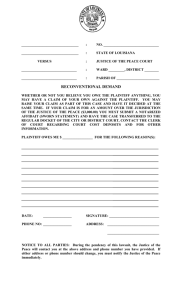
![[2012] NZEmpC 75 Fuqiang Yu v Xin Li and Symbol Spreading Ltd](http://s3.studylib.net/store/data/008200032_1-14a831fd0b1654b1f76517c466dafbe5-300x300.png)
